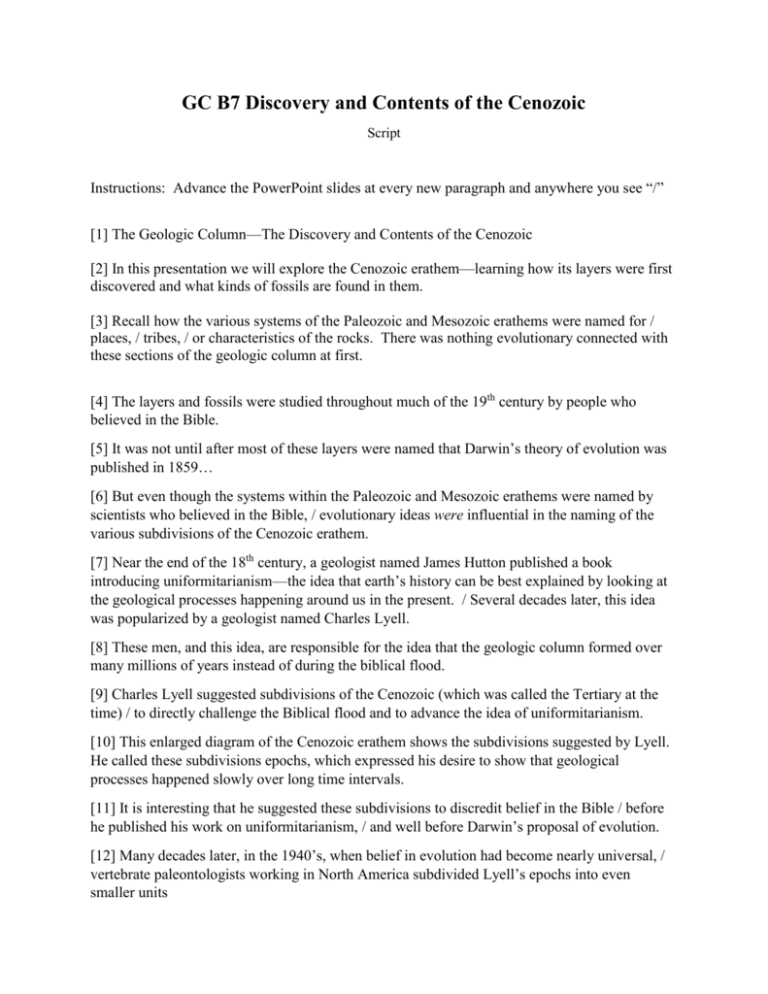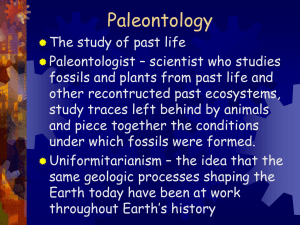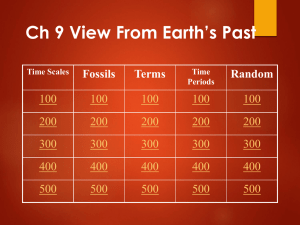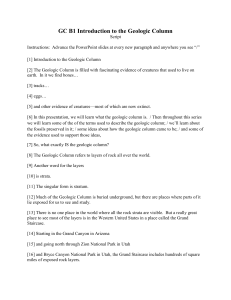Script - Southern Adventist University
advertisement

GC B7 Discovery and Contents of the Cenozoic Script Instructions: Advance the PowerPoint slides at every new paragraph and anywhere you see “/” [1] The Geologic Column—The Discovery and Contents of the Cenozoic [2] In this presentation we will explore the Cenozoic erathem—learning how its layers were first discovered and what kinds of fossils are found in them. [3] Recall how the various systems of the Paleozoic and Mesozoic erathems were named for / places, / tribes, / or characteristics of the rocks. There was nothing evolutionary connected with these sections of the geologic column at first. [4] The layers and fossils were studied throughout much of the 19th century by people who believed in the Bible. [5] It was not until after most of these layers were named that Darwin’s theory of evolution was published in 1859… [6] But even though the systems within the Paleozoic and Mesozoic erathems were named by scientists who believed in the Bible, / evolutionary ideas were influential in the naming of the various subdivisions of the Cenozoic erathem. [7] Near the end of the 18th century, a geologist named James Hutton published a book introducing uniformitarianism—the idea that earth’s history can be best explained by looking at the geological processes happening around us in the present. / Several decades later, this idea was popularized by a geologist named Charles Lyell. [8] These men, and this idea, are responsible for the idea that the geologic column formed over many millions of years instead of during the biblical flood. [9] Charles Lyell suggested subdivisions of the Cenozoic (which was called the Tertiary at the time) / to directly challenge the Biblical flood and to advance the idea of uniformitarianism. [10] This enlarged diagram of the Cenozoic erathem shows the subdivisions suggested by Lyell. He called these subdivisions epochs, which expressed his desire to show that geological processes happened slowly over long time intervals. [11] It is interesting that he suggested these subdivisions to discredit belief in the Bible / before he published his work on uniformitarianism, / and well before Darwin’s proposal of evolution. [12] Many decades later, in the 1940’s, when belief in evolution had become nearly universal, / vertebrate paleontologists working in North America subdivided Lyell’s epochs into even smaller units [13] … which they called the North American Land Mammal Ages. The idea of the land mammal ages was based on the belief of these scientists in evolution. [14] Remember the difference between chronostratigraphic and geochronologic terms? [15] The term “age” is a geochronologic term that includes both the layers themselves and the inferred time associated with them. [16] Referring to these divisions as “stages” instead means we are talking just about the layers, without the inferred millions of years of time associated with them. [17] Even though the idea of the mammal ages was based on evolution, they were actually named the same way as the Paleozoic and Mesozoic--based on fossil communities from a specific place and in a specific sequence. [18] For example, one of the two ages within the Pleistocene epoch was named the Irvingtonian for fossils discovered in Irvington, CA [19] The Blancan age is named for fossils found in Mt. Blanco, TX [20] One of the four ages in the Miocene got its name from the Barstow Formation in CA [21] And one of the four ages in the Oligocene got its name from fossils found in Whitney, NE [22] The name Bridgerian came from the Bridger Formation in Wyoming and is the name of one of four ages in the Eocene epoch. [23] The Paleocene includes four different land mammal ages as well, one of which was named for fossils found in Clark’s Fork Basin, Wyoming. [24] As you can see, the names for the various “ages” are based on a succession of fossil communities, or biomes, preserved at specific places. They do not necessarily mean evolution. [25] What kinds of fossils are found in these Cenozoic fossil communities? A wide variety of creatures including invertebrates, fish, reptiles, and birds. [26] But the most well-known creatures from the Cenozoic layers are mammals--/ like woolly mammoths / and saber-toothed tigers. Because of the variety and number of mammal fossils found there, the Cenozoic has been called the age of mammals. [27] We have spent some time learning about the geologic column—how the various systems got their names [28] and a little bit about what kinds of fossils are found in them. Why is this important? [29] It’s important to understand that the sequence of fossils in the geologic column is real, observable data. / It is also important to understand that the evolutionary interpretation of the geologic column was added later. But is evolution the best explanation for the fossil record? [30] In our next presentation, we will talk about whether or not there is actually evidence within the geologic column for evolution.










